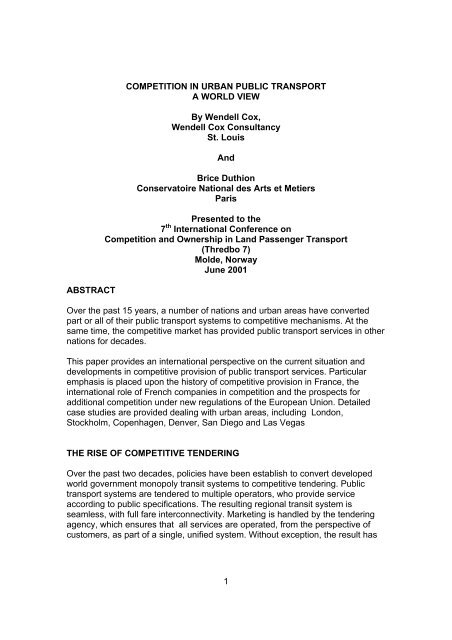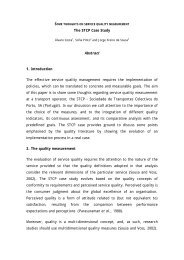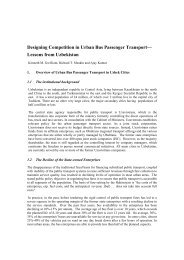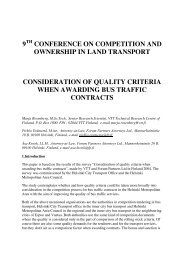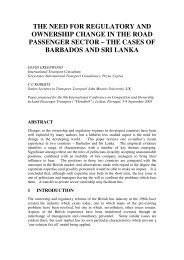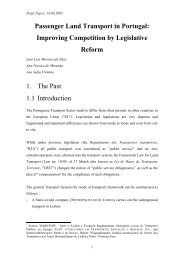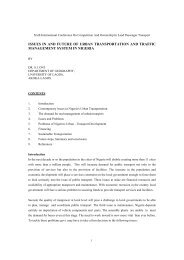1 COMPETITION IN URBAN PUBLIC TRANSPORT AW ORLD VIEW ...
1 COMPETITION IN URBAN PUBLIC TRANSPORT AW ORLD VIEW ...
1 COMPETITION IN URBAN PUBLIC TRANSPORT AW ORLD VIEW ...
You also want an ePaper? Increase the reach of your titles
YUMPU automatically turns print PDFs into web optimized ePapers that Google loves.
ABSTRACT<br />
<strong>COMPETITION</strong> <strong>IN</strong> <strong>URBAN</strong> <strong>PUBLIC</strong> <strong>TRANSPORT</strong><br />
A W <strong>ORLD</strong> <strong>VIEW</strong><br />
By W endelCox,<br />
W endelCox Consultancy<br />
St.Louis<br />
And<br />
Brice Duthion<br />
Conservatoire Nationaldes Arts etMetiers<br />
Paris<br />
Presented to the<br />
7 th InternationalConference on<br />
Competition and Ownership in Land PassengerTransport<br />
(Thredbo 7)<br />
Molde,Norway<br />
June 2001<br />
Over the past 15 years, a number of nations and urban areas have converted<br />
part or al of their public transport systems to competitive mechanisms. At the<br />
same time, the competitive market has provided public transport services in other<br />
nations for decades.<br />
This paper provides an international perspective on the current situation and<br />
developments in competitive provision of public transport services. Particular<br />
emphasis is placed upon the history of competitive provision in France, the<br />
international role of French companies in competition and the prospects for<br />
additional competition under new regulations of the European Union. Detailed<br />
case studies are provided dealing with urban areas, including London,<br />
Stockholm, Copenhagen, Denver, San Diego and Las Vegas<br />
THE RISE OF COMPETITIVE TENDER<strong>IN</strong>G<br />
Over the past two decades, policies have been establish to convert developed<br />
world government monopoly transit systems to competitive tendering. Public<br />
transport systems are tendered to multiple operators, who provide service<br />
according to public specifications. The resulting regional transit system is<br />
seamless, with ful fare interconnectivity. Marketing is handled by the tendering<br />
agency, which ensures that al services are operated, from the perspective of<br />
customers, as part of a single, unified system. Without exception, the result has<br />
1
een cost savings, which vary country to country based upon labor market<br />
conditions.<br />
EUROPE<br />
The European Union (EU) began as a political union. Dating from 1957 with the<br />
Treaty of Roma. It came to symbolise the peace and cooperation of different<br />
nations, just after the Second World War. At first it was a political union, then<br />
transitioning to an economic and monetary union, and then a customs union. In<br />
the last decade, the Treaty of Maastricht (1992, Feb.), laid the foundation stone<br />
of another step, the step of the “real common life”, with his own rules, case laws,<br />
precedents. The “mad cow”disease crisis represented the biggest problem of<br />
this fledgling EU:the gap between a “liberal”policy and a “democratic”vision of<br />
the economy.<br />
France:Public transport is always a matter of contention among political parties.<br />
The 1984 Transportation Act in United Kingdom seems to be for each side either<br />
the worst, or the best, model of deregulation and competition. The French “public<br />
service”inspires the defenders of the welfare state and the local authorities. The<br />
legislative contexts are different, the roles and the functions of the authorities, if<br />
they exist or not, of the companies and of the passengers too.<br />
We will analyse in a first part the French model for transit contracting. We will try<br />
secondly to understand its own evolution, of course in France, but mainly in the<br />
new European policy of regulation. Third, we will take three different examples, in<br />
the south-west French city of Perpignan, actually the one and only network<br />
operated by a non French company, in the German rail network (local and<br />
national)with many French investments, and finally the case of Melbourne,<br />
Australia, strategic place for the development in Asia and Pacific area of the<br />
biggest French operators, private or public.<br />
An important characteristic of transit in France is that there is a clear distinction between<br />
the respective roles of local governments and operators. The “low demand”(insufficient<br />
for commercial operation)for transit is compensated by a “fixed”contribution from the<br />
local government that allows the operator to remain an “entrepreneur”.<br />
The demand of public transport decreased over the years. Until the 1960s, public<br />
transport was profitable in French towns. Demand decreased because of the<br />
high rate of motorization that lead to a reduction of the service supplied soon<br />
followed by their suppression. This motorization phenomenon had happened in<br />
the US before the war, and everywhere in Europe in the 1950s.<br />
In the late 1960s and mainly in the1970s, local government public transport<br />
agencies governments (LTA’s – Local Transit Authorities)assumed responsibility<br />
over public transport. This was made possible by the creation of the public<br />
transport tax (“versement transport”), first in Paris in 1971, and then in the<br />
province areas (a fixed percentage of all wages - between 0,55 and 1,75%, the<br />
highest rate is conditioned by the construction of infrastructure for tramway or<br />
2
subway – of all companies over 9 employees devoted to transit within the LTA’s<br />
territory).<br />
During that early period, contracts are mostly management contracts: the<br />
operator merely operated the system on behalf of the LTA. The case of the Paris<br />
Region is substantially different. There is not an LTA in the Greater Paris (Ile de<br />
France Region), but a public agency with the different levels of political decision<br />
(national, regional and local), the public operators (RATP, Parisian operator, and<br />
the SNCF, public railway operator) and the different private companies operating<br />
in secondary urban networks. This lead to a rapid growth of operating costs to<br />
the LTA’s that got together within GART, whose sole members were LTA. Within<br />
GART, there are discussions about how to get a better involvement of the<br />
operators so that they try to reduce costs.<br />
The first contracts involving actual “risk” for the operators appeared in the<br />
late1970s. A new law (“LOTI”) introduced by the new Mitterrand administration in<br />
1982, the first modern light rail systems in Nantes and Grenoble, lead to the idea<br />
of approaching the issue of global mobility within an LTA’s territory: the PDU’s<br />
(Plans de Déplacements Urbains). Many operating contracts are re-negotiated in<br />
the 1980s and involve specific financial performance bonuses for the operators.<br />
In the 1980s and 1990s, there has been a strong trend toward delegation of<br />
greater risk and responsibility to the private contractors. Delegation would be<br />
called privatization everywhere but it is slightly different. Most networks<br />
previously directly operated by the LTA’s are delegated. Smaller companies are<br />
acquired by the larger ones. Three French companies control the transit<br />
delegation market.<br />
The operator is more often the owner of the rolling stock and must balance a<br />
budget including expenses and revenues from different clients. The LTA is in<br />
most cases the owner of the infrastructure (guided systems), controls fares and<br />
sets fairly precise guidelines for defining transit supply.<br />
The 1993 “Sapin” legislation sets the new guidelines to LTA’s. LTA’s assemblies<br />
are to decide on the principle and characteristics of all delegation of public<br />
services, including transit. They vote on the choice of the operator to whom they<br />
delegate and on the contents of the delegation contract.<br />
The decision to delegate transit and the type of delegation are political choices<br />
that are reflected in the type of delegation contract. One can favor: quality<br />
(comfort, reliability, information), cost (productivity, maintenance), fares (social,<br />
school, unemployed, handicapped), level of service (frequency, capacity), a<br />
combination of these criteria.<br />
The main principles of delegation are described below.<br />
Fares are always set by the LTA. There is a trend for the LTA to try to set its<br />
yearly expenditure for transit once and for all the duration of the delegation<br />
3
contract (no surprises). The operator may get additional incentives to perform<br />
even better (bonuses and penalties).<br />
There are current additional clauses to. A common clause makes it compulsory<br />
for a new operator to hire all his predecessor’s staff (excluding managers). The<br />
operator is often requested for fiscal reasons to manage an investment fund on<br />
behalf of the LTA.<br />
There are three general contract types:<br />
Type 1: contracts with a yearly financial contribution from the LTA<br />
(“contribution forfaitaire”).<br />
Type 2: contracts at a fixed yearly price (“garantie de recettes”)Type 3:<br />
“farmer” type contracts (“gerance”)<br />
Type 1 contracts (Yearly fixed financial contribution from the LTA)<br />
The operator has an operational risk (within reasonable limits) on revenues and<br />
expenditures (Figure #1). The LTA has almost no risk and no surprises. The<br />
deficit proposed by the candidates to the RFP’s for the duration of the contract<br />
are compensated on a yearly basis by the LTA. The commercial risk for the<br />
operator is based on his own revenue projections from the fare box but not on<br />
the fare structure (set by the LTA). The operational risk for the operator is based<br />
on his own productivity projections (better maintenance, better purchasing<br />
policies, better use of staff).<br />
4
ERROR: rangecheck<br />
OFFEND<strong>IN</strong>G COMMAND: .image3<br />
STACK:<br />
-dictionary-<br />
-savelevel-


